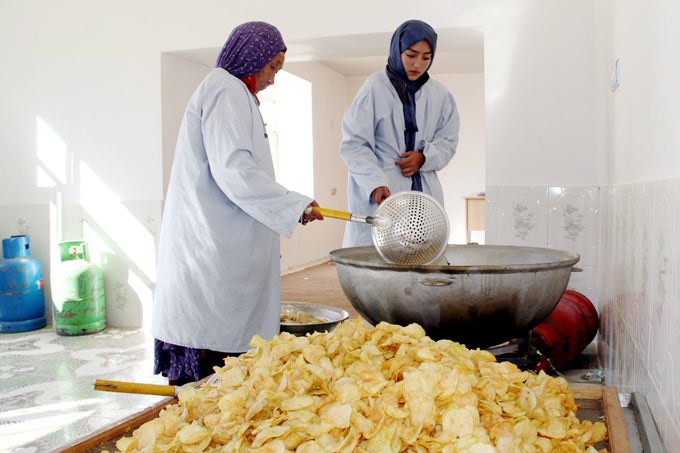“Sabse jyada munafa chuski mein hai (The biggest margin lies in small ice pops)”, says Shanti Devi with the definitive confidence of a seasoned entrepreneur. Shanti, a resident of Kotwana village in Bihar’s Gaya district runs an ice-cream production and sales unit that has an annual revenue of INR 1.9 million and employs 22 workers for a significant part of the year. While sharing the long list of ice-cream flavours she vends, Shanti also signals at a much larger phenomenon. “Every third shop in this market is run by a JEEViKA member, ranging from grocery and utensil stores to a newspaper agency.”
Shanti is the microcosm of a transformative ecosystem that has nurtured 1.8 million new and existing women entrepreneurs while creating 800,000 new jobs in India. The JEEViKA that Shanti refers to, is a World Bank supported program of the Government of Bihar aimed at empowering women through Self-Help groups (SHGs), commodity specific producer groups and higher federations. The approach scaled up nation-wide under the National Rural Livelihoods Mission (NRLM) is driving growth and job creation in rural areas through women-owned enterprises.
Today there are 45 million rural women across India that are mobilized into self-help groups under the NRLM umbrella. Some 3.9 million SHGs and their federations have been empowered with skills, access to finance, markets, and business development services. This is triggering a huge change in the lives of the rural women.
Now women are taking charge, becoming entrepreneurs, and providing jobs to other women.
Over the past 15 years the World Bank has invested USD 3 billion in the unique approach referred to as the rural livelihoods approach to women’s economic empowerment.
The institutions have leveraged USD 25 billion of formal credit over the last five years fuelling a virtuous cycle of productive investment and enabling households to diversify and enhance incomes.
Technical assistance and direct links with some of the biggest private sector companies such as Walmart, Olam, ITC India, NCDEX and TechnoServe are helping bridge the gap between demand and supply, creating more inclusive value chains that deliver economies of scale for producers while improving efficiency for market players.
The World Bank’s portfolio of agriculture and rural transformation projects in India now totals USD 1.7 billion, out of which almost USD 500 million focuses on women-centred enterprise promotion.
There are examples galore that demonstrate the efficacy of this approach in driving sustainable enterprises across sectors.
Women even in active conflict countries such as Afghanistan have run successful enterprises. Miss Rezaee of the all-women Alghochak Potato Chips Cooperative at Azdar village of Bamyan recalls: “When we first started making chips, we neither had equipment and expertise to cook the chips nor were there properly established markets for us to sell to. The Afghanistan Rural Enterprise Development Program (AREDP) provided us the equipment, training and a direct link to 11 schools in Bamyan where we supply 70kgs of potato chips daily.” The cooperative is one of the 300 small enterprises receiving support from the AREDP, supported by the World Bank and Afghanistan Reconstruction Trust Fund (ARTF). The program has created employment opportunities for nearly 12,000 households in Bamyan Province alone. The Government of Afghanistan is now planning to replicate a model akin to NRLM nation-wide (with twinning arrangements with India) with the support of ARTF and International Development Association (IDA) – the Women’s Economic Empowerment Rural Development Program (WEERDP).
Self Employed Women’s Association (SEWA)[1] has connected nearly 800 rural homes in Gujarat in partnership with AirBnB, generating incomes averaging USD 500 a month for hundreds through a “service enterprise” that is home based– a preferred option for millions of women in India and South Asia in general. Tourism operators, transportation services and culinary services have mushroomed in and around these AirBnB homes to cater to this new clientele. Women have invested considerable sums in their home “enterprises” with better sanitation and running water facilities to attract clients, now 40 percent of whom are international. Clearly, mentorship at district and block levels for budding enterprises enhance their success rates. Lean IT based on mobile and cloud-centric solutions is helping drive many of these enterprises.
Aaranyak Farmer Producer Company in Purnea, Bihar has reached USD 2 million in annual turnover, by adopting technology-based solutions for collective aggregation of maize from small farmers, delivering transparent pricing and leveraging online commodity trading platforms to find the most remunerative markets. Similarly, artisan groups in Madhubani, Bihar have been linked to technical assistance partners for design upgradation while e-commerce platforms are being utilized for reaching premium market segments.
NRLM has unleashed the latent entrepreneurial energy of millions of women in rural India. With a massive outreach, the community institution network has the potential to be at once both the enterprise and the market where small businesses of complementary nature exist and thrive in a symbiotic manner. However, a word of caution – self-employment through running of small rural enterprises whether for men or women is not always sustainable.
As Bannerjee and Duflo have pointed out[2] that these are in many cases a means to “buy a job when a more conventional employment opportunity is not available”. These women rural entrepreneurs will need skills, talent, and an appetite for risk to grow their small businesses into successful enterprises. We are seeing this happen now to some extent with a sub-set of these businesses through unique public-private-community partnerships in South Asia that brings in the younger, more educated generations into the running of the business.
For now, the juggernaut of women entrepreneurs rolls on. Shanti, who has accessed INR 500,000 (approx. USD 8000) from her SHG, chuckles “For all I knew, people don’t like ice cream in winters. But I was wrong. This year, I had a few carts operating in the winter season too with special discounts for my SHG members.” Who says only big brands know how to build consumer loyalty!




Join the Conversation